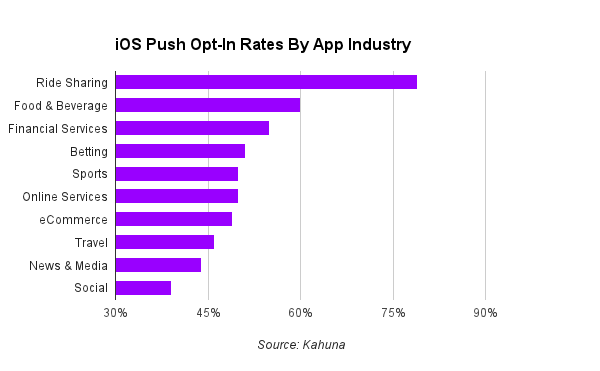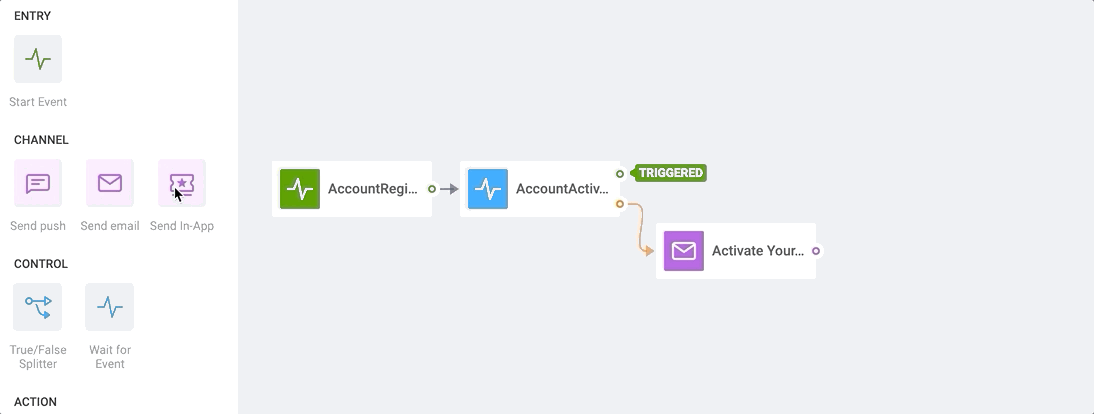Push notifications play an important role in any successful mobile app marketing strategy. They may help you boost engagement, reduce churn rate, and turn inactive users into loyal paying customers. One of the advantages of push notifications is that they don’t require any contact information from users. CTRs are twice as high as emails. Besides, they don’t get stuck in spam filters and the setup is pretty easy. To start working with this channel you need to take two major steps: choose a push provider and subscribe your app users to push notifications.
How to Subscribe Users to Push Notifications
Different platforms have different requirements to the process of building a subscriber base. Let's take Android and iOS, for example.
iOS push notifications opt-in model doesn’t allow app publishers to send notifications before users agree to receive them. The opt-in prompt is default and you can't change the way it looks.

Keep in mind that when you send your first messages to ios users, they will see it on their lock screen. When they unlock the screen, the message will vanish and will be visible only in the notification center. To open it, the user should swipe down and find it in their notification history.
Android Push Notifications Opt-in model is more loyal to app publishers. It automatically opts users in and reserves the right to opt-out manually in the settings. Android makes push notifications much more accessible even after a user unlocks the screen. The messages remain visible on the bar at the top of the screen and won't be removed until the user makes additional efforts to get rid of them.
What's a Good Opt-In Rate?
Basically, there's no such thing as a good opt-in rate. There are 2 main factors that have a significant impact on this metric.
1. The platform type
With automatic push notifications opt-in model, Android has much higher Opt-in rate - around 90-95%. Wherein the average opt-in rate for iOS is around 50%.
2. The industry
It also depends on users' behavior patterns and varies from one industry to another. Travel, e-commerce, media, social media apps have much higher rates. At than B2B, finance, or gaming applications.

Why so? In some cases push notifications become an irreplaceable part of user experience, so users have no other choice than to opt- in.
For example,
- Travel apps users need to know if their flight was canceled or a taxi arrived;
- News lovers would like to be one of the first to know the breaking news and updates regarding important events;
- Social media users want to be notified when they have a new message or missed an important call.
In other cases, it can be less obvious why users should subscribe to push notifications, even though they might seem to be just as helpful.
Does Your App Really Need Push Notifications?
The answer fully depends on your business needs and goals. We asked product and marketing teams that use Pushwoosh iOS and Android push notifications about their needs. This is what they answered about push notifications role in their product and marketing strategies:
- boost features and product adoption;
- increase in-apps CR and improve onboarding experience;
- higher up overall product engagement;
- boost users LTV;
- help monetize the app and grow in-app subscriptions;
So, How Do You Get More Push Notification Subscribers?
The best strategy is to show the value of opting in and provide the context of the notifications you're going to send. The main techniques that will help with it are personalization, segmentation, and experimenting. Let's take a closer look at them.
1. Don’t rush. Wait until the right moment
A lot of app publishers show a subscription prompt right after users register in the app. Is that actually right? As practice shows, the best moment to ask users to opt-in is the 'high intent' moment:
- they view specific products or pages;
- perform specific actions;
- make purchases;
- react to special deals offer;
- go from quality traffic sources;

Here're some examples of high-intent micro-moments:
- E-commerce: after the 1st purchase/when user visits a product or a promotion page for the second time.
- Travel: after the first booking.
- Media: after the user reads several articles on the same topic.
- Social networks: after sending the 1st message/ after adding the 1st contact/ after publishing the 1st post.
2. Customize your pre-permission screens
Let's consider iOS case. Although you can't change the get-permission-screen you can experiment with your pre-permission screens to get more subscribers. Build the funnel or use just one in-app message with a strong value proposition. Here are some examples for the inspiration:


To save your time on in-app funnel setup you can use Pushwoosh Customer Journey Builder to test your hypothesis. Show the whole in-app sequence at once or gradually over time or in response to specific behaviour or status .

3. Personalize your pre-permission screens with custom Tags and Filters
- Create different messages for different segments
Your audience may be divided into segments based on their language, country, traffic source, age, etc. Here are 4 types of segments you can create, depending on your goals:
- Social (income, job role, etc)
- Demographic (age, gender, language, etc)
- Geographic (country, city, specific area, etc)
- Behavioral (time spent in the app, purchase history, email open, etc )
- Use dynamic content
Did you know that even basic personalization can increase your push CTR by 9%? Show your users you know them and care about them. Use Pushwoosh default Tags to adress your user by name, and use their preferences in the message to make it relevant for each user.
→ Learn more about other Personalization features.
4. Make it a part of your welcome series
The first screens that users see when they open your app for the first time have a direct impact on your revenue and key product metrics. If you don't use a paywall, you can set the push notifications opt-in rate as the final point of your onboarding flow. 80% of your users are likely to stop using your app after 30 days if you don’t engage them in communication.
Numbers show that effective onboarding can help you reduce this trend by 50%. Besides push notifications and in-app messages, you can also use emails to implement your onboarding hypothesis. Check the documentation to learn how you can do it all in one place.

5. Use special offers
Everyone loves sales and special offers. That's what makes Q4 such a profitable time for all online businesses. Even if users don't buy your products or services now, you may capture their intent and ask them if they'd like to receive an alert when the prices drop. It works especially well with non-essential goods: flight tickets, hotel bookings, entertainment apps, financial, business products, and so on. You can create a special segment out of those who reacted to this offer, build a special cross-channel workflow to warm them up, and convert into customers.
Ready to Get Started?
- Discover Pushwoosh as a push notification marketing platform.
- Learn more about other companies boost in-app purchases and drive mobile app revenue;
- Check out Pushwoosh Personalization features;
- Try to create your cross-channel communication flows for free;
- Book a demo to get a free consultation on how to improve your mobile app marketing ROI.
